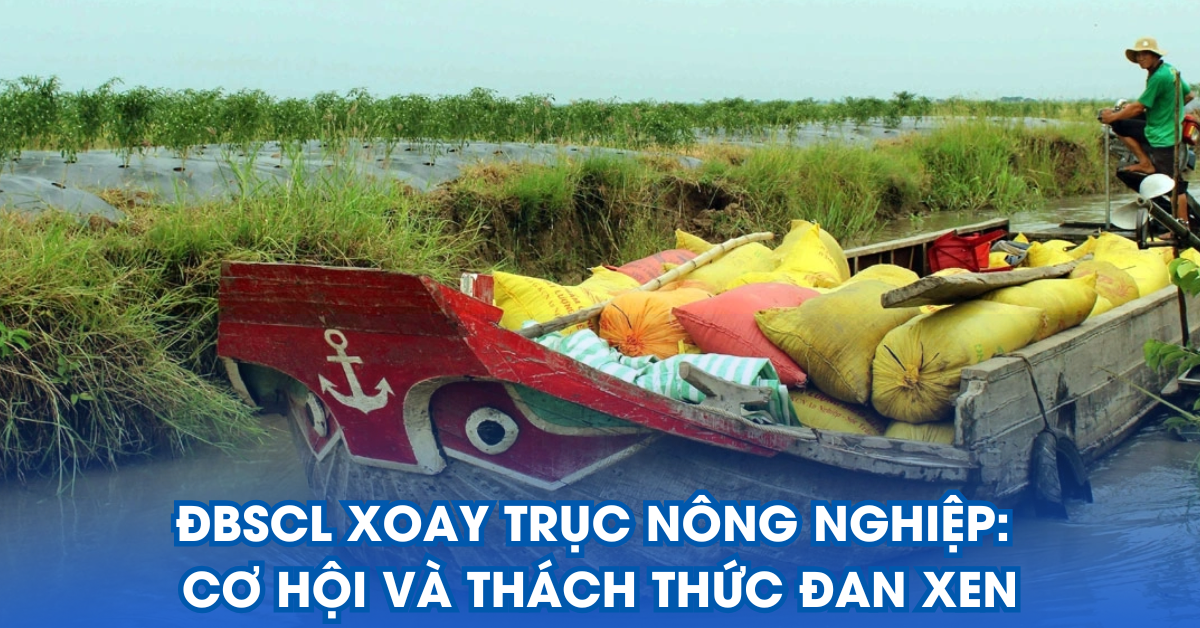Mekong Delta Agricultural Pivot: Opportunities and Challenges Intertwined
26 May 2025

The Mekong Delta is shifting its focus to prioritizing seafood and vegetables to adapt to climate change, but is still facing pollution, code fraud, and product quality.
Why does the Mekong Delta have to pivot agriculture?
In the context of increasingly severe climate change, the Mekong Delta (MD) - the country's largest rice, seafood and fruit granary - is gradually implementing an agricultural "pivot" strategy. Instead of prioritizing rice as before, the MD has shifted its focus to seafood and vegetables, in order to adapt to changing natural conditions and ensure sustainable livelihoods for the people. However, in addition to the initial positive results, this strategy has also faced many challenges, from product quality, trade fraud to the deterioration of the production environment.
Reorienting development for climate change
The “pivot” strategy originates from Resolution 120/NQ-CP (2017) on sustainable development of the Mekong Delta in the context of climate change. Increased saline intrusion, rising sea levels and changes in the flow from the upper Mekong River have reduced the efficiency of the old production model based on rice. According to the new orientation, by 2030, the aquaculture area in the Mekong Delta will increase to about 1 million hectares, focusing on adaptive models such as rice-shrimp and shrimp-forest. Along with that, the area of fruit trees will be expanded by 200,000 hectares, while the rice growing area is expected to decrease from 220,000–300,000 hectares, shifting from output targets to quality and economic efficiency.
Rice-shrimp farming model in the Mekong Delta adapts to climate change. Photo: internet
Initial positive signals
After more than 7 years of implementation, many remarkable changes have appeared. The rice growing area has decreased to below 1.5 million hectares; while the aquaculture and fruit farming areas have increased sharply. The structure of agricultural exports has also changed significantly: in 2024, aquaculture took the lead with 10.07 billion USD, followed by vegetables and fruits (7.12 billion USD) and rice (5.666 billion USD).
Many new models have brought high efficiency, especially the brackish water shrimp farming model in areas affected by saltwater intrusion. Low-yield rice growing areas have been replaced by fruit trees with high export value such as durian, mango, and jackfruit.
Outstanding challenges: Fraud, quality and environment
Despite positive signs, the pivot process still has many worrying issues:
1. Fraudulent codes for growing areas and fruit quality
After Vietnamese durian was officially licensed for export to China, the situation of fraudulent codes for growing areas and packaging facilities increased. Many businesses reported that their codes were impersonated, affecting their reputation and the risk of chemical residue warnings from the import market.
The situation of buying and selling and leasing of growing area codes is common, reducing competitiveness and making it difficult to trace the origin.
Durian - a fruit that has "exploded" in both export sales and growing areas in recent times. Photo: internet
2. Environmental pollution and quality of aquatic breeds
The aquaculture industry also faces many risks. The quality of shrimp breeds has declined, while diseases have increased due to polluted farming environments. Many high-density farming models have failed, forcing people to return to traditional farming methods with low density to ensure efficiency and protect the environment.
Solutions need to be implemented synchronously
For the "pivot" strategy to be truly effective and bring sustainable development to the Mekong Delta, it is necessary to implement synchronous solutions:
- Tighten the management of planting and packaging area codes:
Build a transparent monitoring system, prevent trade fraud, ensure clear traceability.
- Improve the quality of aquaculture breeds and environment:
Invest in research and production of disease-free breeds; encourage farming models suitable for environmental carrying capacity.
- Plan and incite the conversion of some threatened rice area into selected high value adapted crops.
- Promote the processing industry:
Increase product value, ensure stable output and enhance competitiveness in the international market.
- Train and support farmers:
Guide the application of sustainable farming technology and techniques suitable for changing climate conditions.
Conclusion
The Mekong Delta’s agricultural pivot strategy is an inevitable step in the context of increasingly severe climate change. Although there are many difficulties, if the government, businesses and people join forces, this land can completely become a center of sustainable and modern agriculture, contributing greatly to the national economy.
Views
551
